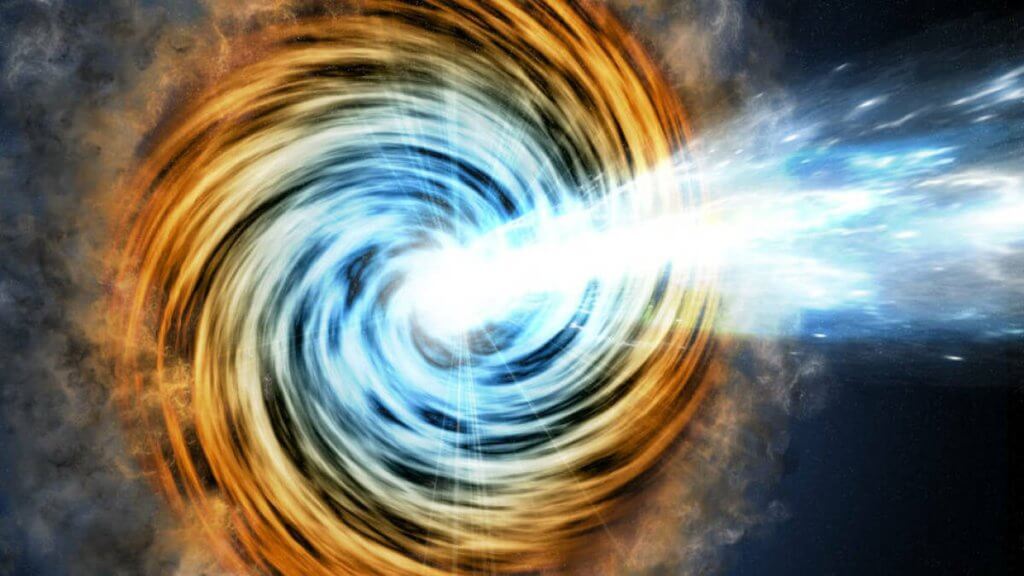
There’s a black hole pointed at Earth. You’re not in danger. (Image Credit: Mashable)
You don’t need to fear black holes.
Over 100 million black holes likely wander our galaxy alone, and they are fascinating objects in the cosmos. They’re unimaginably dense: If Earth was (hypothetically) crushed into a black hole, it would be under an inch across. This profound density gives black holes phenomenal gravitational power. But, fortunately, black holes aren’t cosmic vacuum cleaners. They don’t suck things in, though some objects can veer too close and fall inside, never to return.
You might hear that certain black holes “face Earth” and shoot jets of energy our way, as scientists recently found(Opens in a new tab) in a galaxy over 650 million light-years away. This is true. There are countless black holes out there, and some are invariably positioned toward us. The most massive Earth-facing black holes, which can be billions of times more massive than the sun(Opens in a new tab) and dwell at the center of galaxies, are called “blazars.” They are powerful objects. Even so, these extremely distant objects aren’t a threat.
“You’re safe — unbelievably safe,” Douglas Gobeille, an astrophysicist and black hole researcher at the University of Rhode Island, told Mashable.

Credit: NASA / JPL-Caltech
“You’re safe — unbelievably safe.”
Here’s why blazars shoot energy into space, and why you’re safe from these distant objects.
Black holes shooting energy into space
They don’t swallow much matter that veers nearby. Most stuff gets shredded apart and spins rapidly around the black hole, forming a super-hot, donut-like “accretion disk.”(Opens in a new tab) As this cosmic dust and gas relentlessly spins around, it emits light and energy into space. Crucially, some black hole accretion disks also shoot two jets of energy into space. “Oppositely directed jets of gas often form in the innermost zone of black hole accretion disks,” NASA explains(Opens in a new tab).
The largest black holes — and those emitting the most light into space — live at the center of galaxies. And when one of these black holes happens to be oriented in such a way that a jet is emitting light toward Earth, it’s called a blazar. “It’s more or less pointed straight at you — it’s dumb luck,” Gobeille explained.
Of course, many of the giant black holes at galactic centers, called “active galactic nuclei,” aren’t pointed at us, so we see them from a different angle and can sometimes detect both jets shooting into space, as shown below. It’s a bit like seeing different views of a peacock with its glorious tail open, explained Jean Creighton, an astronomer and the director of the Manfred Olson Planetarium at the University of Wisconsin–Milwaukee. If we could only see a peacock from the side, as opposed to the front, we’d notice far different details. Seeing a blazar is similar. “It’s basically the same thing seen from a different angle,” Creighton told Mashable.

Credit: ESO / WFI (visible) // MPIfR / ESO / APEX / A.Weiss et al. (microwave) // NASA / CXC / CfA / R.Kraft et al. (X-ray)

Credit: Institute for Astronomy at the University of Hawaii / Pan-STARRS
Astronomers observe many different black holes, from varying angles, to better grasp these mysterious objects in the cosmos. Our galaxy, too, has a supermassive black hole called Sagittarius A*(Opens in a new tab). But these objects, however powerful, are not a danger.
Why black hole blazars are not a threat
The universe is teeming in light — but much of it isn’t the narrow band of light we can see.
Many energetic events in deep space, such as star explosions, give off light in radio waves, which large radio telescopes regularly detect. Astronomers glimpse the far-off activity of black holes using radio wave observations, too, and this ancient light, or energy, is harmless. How harmless? “These are very faint signals. The amount of energy collected in radio astronomy’s history is less than the energy needed to melt a snowflake,” Yvette Cendes, an astronomer and postdoctoral fellow at the Harvard-Smithsonian Center for Astrophysics(Opens in a new tab), told Mashable earlier this year.
“They’re lower energy,” Gobeille emphasized.
And, of course, black holes are great distances away from us. The galaxy PBC J2333.9-2343, which scientists recently reclassified as a blazar, is hundreds of millions of light-years away. If we squeezed the galaxy onto the University of Wisconsin–Milwaukee campus, relative to its size we’d be farther away than Caracas, Venezuela, in South America. “There’s absolutely no reason to worry about a black hole at that distance,” Creighton said.

Credit: NASA
Want more science and tech news delivered straight to your inbox? Sign up for Mashable’s Top Stories newsletter today.
So, yes, black holes like one at the center of the galaxy PBC J2333.9-2343 are “looking” directly at us and emitting light into space. But this energy isn’t nearly a threat. After all, the real threats are here on Earth, not out in the cosmos.
“People need to worry more about Earth, and never mind the things that are far away,” Creighton said.
This story, originally published on April 1, 2023, has been updated with more information about black holes.





